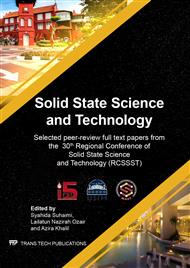[1]
N. Ismail, A. Jalar, M.A. Bakar, R. Ismail, Effect of carbon nanotube addition on the growth of intermetallic later of Sn-Ag-Cu solder system under thermal aging, Sains. Malays. 47(7) (2018) 1585-1590.
DOI: 10.17576/jsm-2018-4707-29
Google Scholar
[2]
F.C. Ani, A. Jalar, A.A. Saad, C.Y. Khor, R. Ismail, Z. Bachok, M.A. Abas, N.K. Othman, SAC–xTiO2 nano-reinforced lead-free solder joint characterizations in ultra-fine package assembly, Solder Surf. Mt. Tech. 30 (2018) 1-13.
DOI: 10.1108/ssmt-04-2017-0011
Google Scholar
[3]
M.A.A Mohd Salleh, A.M. Mustafa Al Bakri, H. Kamarudin, M. Bnhussain, Zan@Hazizi M.H & F. Somidin. Solderability of Sn-0.7Cu/Si3N4 lead-free composite solder on Cu-substrate, Physics Procedia 22 (2011) 299-304.
DOI: 10.1016/j.phpro.2011.11.047
Google Scholar
[4]
M. Nagakura, Y. Tanimoto, N. Nishiyama, Color stability of glass-fiber-reinforced polypropylene for non-metal clasp dentures. J. Prosthodont. Res. 62 (2018) 31-34.
DOI: 10.1016/j.jpor.2017.05.007
Google Scholar
[5]
Y. Tang, C. Wu, Y. Song, Y. Zheng, L. Zhao, Effect of colouration mechanicsm and stability of CoAl2O4 ceramic pigments sintered on substrates. Ceram. Int. 44 (2018) 1019-1025.
DOI: 10.1016/j.ceramint.2017.10.038
Google Scholar
[6]
N. Ismail, R. Ismail, A. Jalar, G. Omar, E.M. Salleh, N. Kamil, I.A. Rahman, Comparative study of interfacial interaction between aromatic and aliphatic functional group in solder wettability, J. Mater. Sci. Mater. Electron. 29 (2018) 12910-12916.
DOI: 10.1007/s10854-018-9410-8
Google Scholar
[7]
X.D. Liu, Y.D. Han, H.Y. Jing, J. Wei, L.Y. Xu. Effect of graphene nanosheets reinforcement on the performance of Sn–Ag–Cu lead-free solder. Mater. Sci. Eng. A 562 (2013) 25–32.
DOI: 10.1016/j.msea.2012.10.079
Google Scholar
[8]
C. Golcalves, H. Leitao, C.S. Lau, J.C. Teixeira, L. Ribas, S. Teixeira, M.F. Cerqueira, F. Macedo, D. Soares. Wetting behaviour of SAC305 solder on different substrates in high vacuum and inert atmosphere. J. Mater. Sci.: Mater. Electron (2015) 26: 5106-5112.
DOI: 10.1007/s10854-015-3037-9
Google Scholar
[9]
L.M. Liu & M.A., Ahmad, Interfacial reaction of Sn-Ag-Cu solder alloy on Cu: A review, Advances in Materials Science and Engineering (2013) Vol. 2013 :1-11.
DOI: 10.1155/2013/123697
Google Scholar
[10]
F, Przemyslaw, G. Tomaasz, P. Janusz, B. Krystyna, S. Janusz, Thermophysical properties and wetting behaviour on Cu of selected SAC alloys, Soldering & Surface Mount Technology (2012) 24(2): 71-76.
DOI: 10.1108/09540911211214640
Google Scholar
[11]
Z. Peng, X. Songbai, W. Jianhao, X. Peng, Z. Sujuan, L. Weimin, Effect of nanoparticles on the microstructure and properties of lead-free solders: A review, Appl. Sci. (2019) (9): 1-20.
Google Scholar
[12]
A.M. Erer, S. Oguz, Y. Türen, Influence of bismuth (Bi) addition on wetting characteristics of Sn-3Ag-0.5Cu solder alloy on Cu substrate, Eng. Sci. Technol. Int J. (2018) Article in Press.
DOI: 10.1016/j.jestch.2018.10.002
Google Scholar
[13]
H. Biana, W. Fua, Y.Z. Leib, X.G. Song, D. Liu, J. Cao, J.C. Feng, Wetting and low temperature bonding of zirconia metallized with Sn0.3Ag0.7Cu-Ti alloys, Ceram. Int. 44 (2018) 11456-11465.
DOI: 10.1016/j.ceramint.2018.03.207
Google Scholar
[14]
D. Giuranno, S. Delsante, G. Borzone, R. Novakovic, Effect of Sb addition on the properties of Sn-Ag-Cu/(Cu, Ni) solder systems, J. Alloy Compd. 689 (2016) 918-930.
DOI: 10.1016/j.jallcom.2016.08.035
Google Scholar
[15]
B.L. Silva, N. Cheung, A. Garcia, J.E. Spinelli. Evaluation of solder/substrate thermal conductance and wetting angle of Sn-0.7wt%Cu-(0.01 wt%Ni) solder alloys, Mater. Lett. 142 (2015) 163-167.
DOI: 10.1016/j.matlet.2014.11.088
Google Scholar
[16]
G. Chen, H. Peng, V.V. Silberschmidt, Y.C. Chan, C. Liu, F. Wu. Performance of Sn-3.0Ag-0.5Cu composite solder with TiC reinforcement: Physical properties, solderability and microstructural evolution under isothermal ageing. J. Alloy Compd. 685 (2016) 680-689.
DOI: 10.1016/j.jallcom.2016.05.245
Google Scholar
[17]
L.C. Tsao, S.Y. Chang, C.I. Lee, W.H. Sun, C.H. Huang. Effects of nano-Al2O3 additions on microstructure development and hardness of Sn3.5Ag0.5Cu solder. Mater. Design 31 (2010) 4831–4835.
DOI: 10.1016/j.matdes.2010.04.033
Google Scholar
[18]
S.M.L. Nai, J. Wei, M. Gupta. Influence of ceramic reinforcements on the wettability and mechanical properties of novel lead-free solder composites. Thin Solid Films 504 (2006) 401-404.
DOI: 10.1016/j.tsf.2005.09.057
Google Scholar


